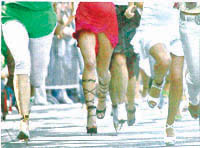
Bronce figure of a girl at race, probably from the area of Sparta/Greace.
Height 11,4 cm, Britisches Museum London. about 520-500 bev.Chr.

SZ, 21.08.2006, PANORAMA,
stiletto-run, Berlin
stiletto-run, Berlin
Talk by Nora Sdun, Hamburg
15.12.2006
High-heel shoes and stubbles do have no
close connection etymologically. To put a high heel on a shoe means to
put a small wooden block under it with wich usually one cobbles the
street. "Einem etwas stoeckeln"
(literally translated: to high-heel someone*) in metaphorical use means
to secretly advice, to secretly give news, which goes along with
similar meaning terms like "einem
etwas unter den Fu§ geben, jemand
etwas stšckeln", hence to place under the sole (news), to give a
standpoint.
And stubbles are stubbles - if as beard or as harvested field.
That it does not work out with etymology right away does not keep me from beginning.
Looking at the different options of making a fool of oneself one can develop this rule of thumb - matriarchy there and forth: compared to men women have a much wider range in ways of single or combined expressions of anything urgent, hence methods to behave to which belongs making a fool of oneself. Men on the other hand always play one role, that is James Bond. No matter if they are as spectator or as fast-forward, in the football stadium, and that applies for their behaviour in the opera as well.
The showing-off behaviour of heterosexual men is very very similar in any case.
As since some time one has indeed been in partriachal situations one can say: good, obviously men have practically invented that. They so-to-say are not under pressure of innovation with their James-Bond-model as they have the power to establish it as the only cool model. Always women exercise the truly weird things and mostly for men, even if they do not do it for men women have tasks of which men claim having assigned those to them as well, certainly women take this over oviously also without assignment: they are responsible for general fertility. Of course this is not so clearly to see with men. The wider range in behaviour patterns of women is an inheritance of patriarchal obligation which is appointed excellently though against the chivalrous subduers.
If one gets closer carefully now to the area of cult- and sacrificial acts one gets rather soon to psychologically extreme and physically painful if not deadly constellations. Acts of sacrifice are calculating they are always done when one has the
And stubbles are stubbles - if as beard or as harvested field.
That it does not work out with etymology right away does not keep me from beginning.
Looking at the different options of making a fool of oneself one can develop this rule of thumb - matriarchy there and forth: compared to men women have a much wider range in ways of single or combined expressions of anything urgent, hence methods to behave to which belongs making a fool of oneself. Men on the other hand always play one role, that is James Bond. No matter if they are as spectator or as fast-forward, in the football stadium, and that applies for their behaviour in the opera as well.
The showing-off behaviour of heterosexual men is very very similar in any case.
As since some time one has indeed been in partriachal situations one can say: good, obviously men have practically invented that. They so-to-say are not under pressure of innovation with their James-Bond-model as they have the power to establish it as the only cool model. Always women exercise the truly weird things and mostly for men, even if they do not do it for men women have tasks of which men claim having assigned those to them as well, certainly women take this over oviously also without assignment: they are responsible for general fertility. Of course this is not so clearly to see with men. The wider range in behaviour patterns of women is an inheritance of patriarchal obligation which is appointed excellently though against the chivalrous subduers.
If one gets closer carefully now to the area of cult- and sacrificial acts one gets rather soon to psychologically extreme and physically painful if not deadly constellations. Acts of sacrifice are calculating they are always done when one has the
impression that
with it one obtains protection sometimes even a garantee for success of
an undertaking. Someone planning a sea journey would hardly ask the
gods of music but rather the gods of the seas (there is a reason for
the clear jurisdiction of the gods).
This connection can also be observed with the travel companions that Elke Suhr has gathered here.
So what should one do when one wants to optimize the output of a harvest? One simply makes a sacrifice to the soil in which the vegetable grows. One wants to force favourable conditions and claims that the soil needs a sacrifice, best of which a bloody one of course. Blood is always great. On stage artificial blood is the liquid that is available by the container. As soon as one can see it blood transfers threat and hurt at the same time, when one bleeds too long one dies eventually, same with hyperventilating - but that is too common. Blood sacrifices like other sacrifices are rather silly because a direct effect could not have been found so far. An indirect one though always, that is this threatening and shuddering, and that is what it is about.
If larger parts of the population of the 18th. and 19th. century liked blood-letting and fighting a duel because now being educated had to admit that efficacy of blood-sacrifices is questionable but did not want to give up their dependency on the direct effects of the blood?
At frequently occuring painful sacrifices like for example the yearly thanksgiving celebrations it is best if persons do that over which one has power of disposition - women. The fitting pattern of thinking here: the soil as the ever again nourishing on which fruits grow, hence a clear case: domaine of women.
This constellation of thanksgiving and women is by the way completely constructed and is devoid of any realistic observa-
This connection can also be observed with the travel companions that Elke Suhr has gathered here.
So what should one do when one wants to optimize the output of a harvest? One simply makes a sacrifice to the soil in which the vegetable grows. One wants to force favourable conditions and claims that the soil needs a sacrifice, best of which a bloody one of course. Blood is always great. On stage artificial blood is the liquid that is available by the container. As soon as one can see it blood transfers threat and hurt at the same time, when one bleeds too long one dies eventually, same with hyperventilating - but that is too common. Blood sacrifices like other sacrifices are rather silly because a direct effect could not have been found so far. An indirect one though always, that is this threatening and shuddering, and that is what it is about.
If larger parts of the population of the 18th. and 19th. century liked blood-letting and fighting a duel because now being educated had to admit that efficacy of blood-sacrifices is questionable but did not want to give up their dependency on the direct effects of the blood?
At frequently occuring painful sacrifices like for example the yearly thanksgiving celebrations it is best if persons do that over which one has power of disposition - women. The fitting pattern of thinking here: the soil as the ever again nourishing on which fruits grow, hence a clear case: domaine of women.
This constellation of thanksgiving and women is by the way completely constructed and is devoid of any realistic observa-
If the reader knows of one, please let us know. P.S./E. S.